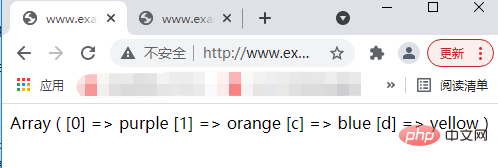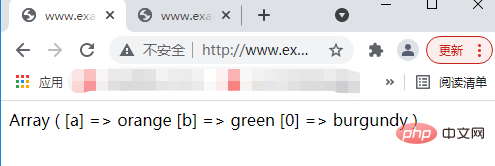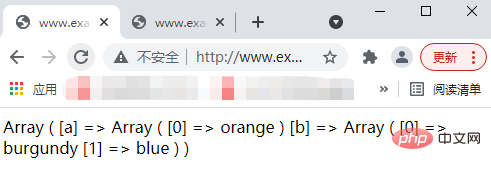 Backend Development
Backend Development
 PHP Tutorial
PHP Tutorial
 Take you to quickly master the replacement of PHP array elements (detailed examples)
Take you to quickly master the replacement of PHP array elements (detailed examples)
Take you to quickly master the replacement of PHP array elements (detailed examples)
In the previous article "Learn three methods to obtain multiple array differences (collection)", it introduced in detail the relevant knowledge on how to obtain the array difference method in PHP. In this article we Let’s take a look at the relevant knowledge about how to replace elements in an array in PHP. I hope it will be helpful to everyone!

In the previous article, we mentioned that if you want to replace a string in PHP, you can use the str_replace function and substr_replace() function, strings and arrays are very important data types in PHP, so how can we replace elements in the array?
In PHP, you can replace elements in the array through the array_splice function, the array_replace function and the array_replace_recursive function. Below we will Let’s take a look at how to use these three functions respectively.
<strong><span style="font-size: 20px;">array_splice</span></strong>Function
# can be passed in PHP ##array_spliceThe function removes an element from an array and replaces it with a new element. array_spliceThe basic syntax format of the function is as follows:
1 |
|
array represents the array we need to operate on. The parameter start is used to represent the starting position of deleted elements. The parameter length It is used to specify the number of elements to be removed, and it is also the length of the array in the returned result. The second parameter array is used to specify the array with the elements to be inserted into the original array.
start is a positive number, it means starting to remove from the offset specified by the value in the array. If this parameter is a negative number, it means to start removing from the end of the array at the offset specified by the value. If it is 0, it will be removed starting from the first element.
lengthIf it is a positive number, it means the number of elements to remove. If it is a negative number, it means to remove the countdown length from start to the end of the array. All elements in the middle up to . If the value of this parameter is not set, it means to remove all elements from the position set by the start parameter to the end of the array.
array_splice function through an example. The example is as follows:
1 2 3 4 5 6 |
|

array_splice function. Let’s take a look at the other two methods.
<strong>array_replace<span style="max-width:90%"></span></strong>Function
array_replace Function to replace the value of the first array with the value of the following array. array_replace The basic syntax format of the function is as follows:
1 |
|
NULL.
1 2 3 4 5 |
|

1 2 3 4 5 |
|

1 2 3 4 5 6 |
|

上述示例中,出现了三个数组,这时候需要注意的是,后面数组的值会覆盖前面数组的值。
这便是array_replace函数的基本用法,下面我们继续来看array_replace_recursive函数的用法。
array_replace_recursive函数
在PHP中可以通过array_replace_recursive函数来递归的使用第二个数组的值来替换第二个数组的值。
array_replace_recursive函数的基本语法格式如下:
1 |
|
其中需要注意的是:
参数array1表示的是我们需要被替换的数组,参数array2表示的是指定要替换array1的值的数组,array3表示的是指定多个需要替换的数组,后面的数值会覆盖前面的数值。返回的结果是被替换的数组,如果函数其中有错误的话,返回的结果就是NULL。
如果数组中没有使用指定的键来规定数组中的元素,那么array_replace_recursive函数就可以看成是array_replace函数。
如果一个键在第一个数组和第二个数组中都存在,这时候第二个数组的值会替换第一个数组的值,如果一个键只存在于第一个数组,那么这个值会保存,如果一个键只存在于第二个数组,这时候会在第一个数组创建一个一样的元素。
下面我们通过示例来看一下array_replace_recursive的使用,示例如下:
1 2 3 4 5 6 |
|
输出结果:

上述示例中,多个数组后面的数值会覆盖前面的数值。
大家如果感兴趣的话,可以点击《PHP视频教程》进行更多关于PHP知识的学习。
The above is the detailed content of Take you to quickly master the replacement of PHP array elements (detailed examples). For more information, please follow other related articles on the PHP Chinese website!

Hot AI Tools

Undresser.AI Undress
AI-powered app for creating realistic nude photos

AI Clothes Remover
Online AI tool for removing clothes from photos.

Undress AI Tool
Undress images for free

Clothoff.io
AI clothes remover

Video Face Swap
Swap faces in any video effortlessly with our completely free AI face swap tool!

Hot Article

Hot Tools

Notepad++7.3.1
Easy-to-use and free code editor

SublimeText3 Chinese version
Chinese version, very easy to use

Zend Studio 13.0.1
Powerful PHP integrated development environment

Dreamweaver CS6
Visual web development tools

SublimeText3 Mac version
God-level code editing software (SublimeText3)

Hot Topics
 1655
1655
 14
14
 1413
1413
 52
52
 1306
1306
 25
25
 1252
1252
 29
29
 1226
1226
 24
24
 Explain JSON Web Tokens (JWT) and their use case in PHP APIs.
Apr 05, 2025 am 12:04 AM
Explain JSON Web Tokens (JWT) and their use case in PHP APIs.
Apr 05, 2025 am 12:04 AM
JWT is an open standard based on JSON, used to securely transmit information between parties, mainly for identity authentication and information exchange. 1. JWT consists of three parts: Header, Payload and Signature. 2. The working principle of JWT includes three steps: generating JWT, verifying JWT and parsing Payload. 3. When using JWT for authentication in PHP, JWT can be generated and verified, and user role and permission information can be included in advanced usage. 4. Common errors include signature verification failure, token expiration, and payload oversized. Debugging skills include using debugging tools and logging. 5. Performance optimization and best practices include using appropriate signature algorithms, setting validity periods reasonably,
 How do you parse and process HTML/XML in PHP?
Feb 07, 2025 am 11:57 AM
How do you parse and process HTML/XML in PHP?
Feb 07, 2025 am 11:57 AM
This tutorial demonstrates how to efficiently process XML documents using PHP. XML (eXtensible Markup Language) is a versatile text-based markup language designed for both human readability and machine parsing. It's commonly used for data storage an
 Explain late static binding in PHP (static::).
Apr 03, 2025 am 12:04 AM
Explain late static binding in PHP (static::).
Apr 03, 2025 am 12:04 AM
Static binding (static::) implements late static binding (LSB) in PHP, allowing calling classes to be referenced in static contexts rather than defining classes. 1) The parsing process is performed at runtime, 2) Look up the call class in the inheritance relationship, 3) It may bring performance overhead.
 PHP Program to Count Vowels in a String
Feb 07, 2025 pm 12:12 PM
PHP Program to Count Vowels in a String
Feb 07, 2025 pm 12:12 PM
A string is a sequence of characters, including letters, numbers, and symbols. This tutorial will learn how to calculate the number of vowels in a given string in PHP using different methods. The vowels in English are a, e, i, o, u, and they can be uppercase or lowercase. What is a vowel? Vowels are alphabetic characters that represent a specific pronunciation. There are five vowels in English, including uppercase and lowercase: a, e, i, o, u Example 1 Input: String = "Tutorialspoint" Output: 6 explain The vowels in the string "Tutorialspoint" are u, o, i, a, o, i. There are 6 yuan in total
 PHP and Python: Comparing Two Popular Programming Languages
Apr 14, 2025 am 12:13 AM
PHP and Python: Comparing Two Popular Programming Languages
Apr 14, 2025 am 12:13 AM
PHP and Python each have their own advantages, and choose according to project requirements. 1.PHP is suitable for web development, especially for rapid development and maintenance of websites. 2. Python is suitable for data science, machine learning and artificial intelligence, with concise syntax and suitable for beginners.
 What are PHP magic methods (__construct, __destruct, __call, __get, __set, etc.) and provide use cases?
Apr 03, 2025 am 12:03 AM
What are PHP magic methods (__construct, __destruct, __call, __get, __set, etc.) and provide use cases?
Apr 03, 2025 am 12:03 AM
What are the magic methods of PHP? PHP's magic methods include: 1.\_\_construct, used to initialize objects; 2.\_\_destruct, used to clean up resources; 3.\_\_call, handle non-existent method calls; 4.\_\_get, implement dynamic attribute access; 5.\_\_set, implement dynamic attribute settings. These methods are automatically called in certain situations, improving code flexibility and efficiency.
 PHP: A Key Language for Web Development
Apr 13, 2025 am 12:08 AM
PHP: A Key Language for Web Development
Apr 13, 2025 am 12:08 AM
PHP is a scripting language widely used on the server side, especially suitable for web development. 1.PHP can embed HTML, process HTTP requests and responses, and supports a variety of databases. 2.PHP is used to generate dynamic web content, process form data, access databases, etc., with strong community support and open source resources. 3. PHP is an interpreted language, and the execution process includes lexical analysis, grammatical analysis, compilation and execution. 4.PHP can be combined with MySQL for advanced applications such as user registration systems. 5. When debugging PHP, you can use functions such as error_reporting() and var_dump(). 6. Optimize PHP code to use caching mechanisms, optimize database queries and use built-in functions. 7
 PHP in Action: Real-World Examples and Applications
Apr 14, 2025 am 12:19 AM
PHP in Action: Real-World Examples and Applications
Apr 14, 2025 am 12:19 AM
PHP is widely used in e-commerce, content management systems and API development. 1) E-commerce: used for shopping cart function and payment processing. 2) Content management system: used for dynamic content generation and user management. 3) API development: used for RESTful API development and API security. Through performance optimization and best practices, the efficiency and maintainability of PHP applications are improved.



